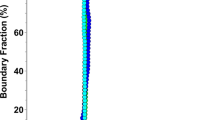Abstract
After purification to homogeneity by Bio-Rex 70 ion exchange chromatography, micromolar solutions ofNaja nigricollis cardiotoxin were found to contain significant amounts of aggregates, as detected by time-resolved polarized fluorescence of its single tryptophan residue. The level of cardiotoxin aggregation depends strongly and reversibly on the protein concentration and pH. However, supplementary reverse-phase HPLC completely suppresses this aggregation, resulting in all cases in fluorescence anisotropy decays characteristic of the pure cardiotoxin monomer. The self-association properties of cardiotoxin, in the presence of a possible cofactor eliminated by the HPLC step, may be functionally relevant, and would deserve further investigation. The physical heterogeneity of the cardiotoxin samples required an appropriate model for the analysis of fluorescence depolarization, which was iteratively improved by comparison with experimental results. In this way, an approximate molar fraction of 10–15% aggregated cardiotoxin at a 90ΜM total protein concentration, pH 7, was determined. The fluorescence of the partly aggregated samples is significantly perturbed as compared to the HPLC-treated monomer, indicating that the cardiotoxin aggregate must have an increased average fluorescence lifetime and a strongly decreased initial anisotropy. The decrease in initial anisotropy suggests either an increased mobility of the tryptophan residue upon aggregation or fast energy transfers between residues of different cardiotoxin molecules brought within a short distance in the aggregate. This study illustrates the high sensitivity of the time-resolved fluorescence technique, through both total fluorescence and anisotropy parameters, to low levels of physical or chemical heterogeneity in a protein sample.
Similar content being viewed by others
References
M. J. Dufton and R. C. Hider (1988)Pharmacol Ther. 36, 1–40.
B. Rees, J.-P. Samama, J.-C. Thierry, M. Gilibert, J. Fischer, H. Schweitz, M. Lazdunski, and D. Moras (1987)Proc. Natl. Acad. Sci. 84, 3132–3136.
A. L. Harvey (1985)J. Toxicol. Toxin. Rev. 4, 41–69.
A. Ménez, E. Gatineau, C. Roumestand, A. L. Harvey, L. Mouawad, B. Gilquin, and F. Toma (1990)Biochimie 72, 575–588.
P. Blandin, F. Mérola, J.-C. Brochon, O. Trémeau, and A. Ménez (1994)Biochemistry 33, 2610–2619.
J. Lee, Y. Wang, and B. G. Gibson (1991)J. Fluoresc. 1, 23–29.
M. Vincent, I. M. Li de la Sierra, M. N. Berberan-Santos, A. Diaz, M. Diaz, G. Padron, and J. Gallay (1992)Eur. J. Biochem. 210, 953–961.
J.-C. Brochon, P. Tauc, F. Mérola, and B. M. Schoot (1993)Anal. Chem. 65, 1028–1034.
T. Fernando and C. Royer (1992)Biochemistry 31, 3429–3441.
J. L. Silva, C. F. Silveira, A. Correia Jr., and L. Pontes (1992)J. Mol. Biol. 223, 545–555.
J. Gallay, M. Vincent, I. M. Li de la Sierra, J. Alvarez, R. Ubieta, and J. Madrazo (1993)Eur. J. Biochem. 211, 213–219.
M. Jullien (1989)FEBS Lett. 253, 38–42.
S. R. Anderson (1991)J. Biol. Chem. 266, 11405–11408.
R. Liao, C. K. Wang, and H. C. Cheung (1992)Biophys. J. 63, 986–995.
R. Rigler and M. Ehrenberg (1973)Q. Rev. Biophys. 6, 139–199.
R. D. Ludescher, L. Peting, S. Hudson, and B. Hudson (1987)Biophys. Chem. 28, 59–75.
J.-C. Brochon and A. Livesey (1988) in R. H. Douglas, J. Moan, and F. Dall'Acqua (Eds.),Light in Biology and Medicine, Vol. 1, pp. 21–29.
J.-C. Brochon, F. Mérola, and A. K. Livesey (1992) in American Institute of Physics (Ed.),Synchrotron Radiation and Dynamic Phenomena, New York, pp. 435–450.
L. Fryklund and D. Eacker (1975)Biochemistry 14, 2865–2871.
J. M. Grognet (1988) Thèse de 3ème Cycle, Paris V.
E. Gatineau, M. Takechi, F. Bouet, P. Mansuelle, H. Rochat, A. L. Harvey, T. Montenay-Garestier, and A. Ménez (1990)Biochemistry 29, 6480–6489.
S. J. Hodges, A. S. Agbaji, A. L. Harvey, and R. C. Hider (1987)Eur. J. Biochem. 165, 373–383.
A. K. Livesey and J.-C. Brochon (1987)Biophys. J. 52, 693–706.
F. Mérola, R. Rigler, A. Holmgren, and J.-C. Brochon (1989)Biochemistry 28, 3383–3398.
B. Valeur and G. Weber (1977)Photochem. Photobiol. 25, 441–444.
P. Wahl (1979)Biophys. Chem. 10, 91–104.
P. Blandin (1990) Rapport de stage de DEA, Paris XI.
M. R. Eftink, I. Gryczynski, W. Wiczk, G. Laczko, and J. R. Lakowicz (1991)Biochemistry 30, 8945–8953.
J. B. A. Ross, K. W. Rousslang, and L. Brand (1981)Biochemistry 20, 4361–4369.
F. Claesens and R. Rigler (1986)Eur. Biophys. J. 13, 331–342.
M. Chabbert, W. Hillen, D. Hansen, M. Takahashi, and J. A. Bousquet (1992)Biochemistry 31, 1951–1960.
T. C. Werner and L. S. Forster (1979)Photochem. Photobiol. 29, 905–914.
Author information
Authors and Affiliations
Rights and permissions
About this article
Cite this article
Mérola, F., Blandin, P., Brochon, J.C. et al. Aggregation ofNaja nigricollis cardiotoxin: Characterization and quantitative estimate by time-resolved polarized fluorescence. J Fluoresc 5, 205–215 (1995). https://doi.org/10.1007/BF00727541
Received:
Revised:
Accepted:
Issue Date:
DOI: https://doi.org/10.1007/BF00727541




